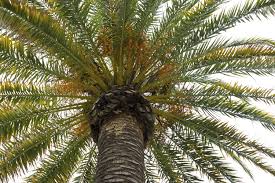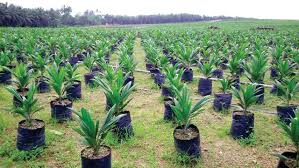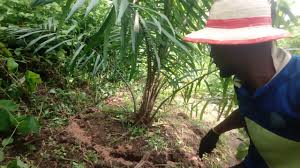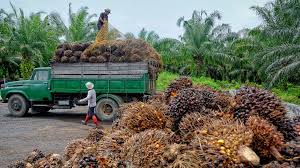This article covers the cultivation, production, and processing of oil palm. Given the wide distribution of palms and their various types, the cultivation of other types of palms is also addressed.
History of Oil Palm
Palm oil, derived from the African oil palm (Elaeis guineensis), has long been recognized in West African countries, where it is widely used as cooking oil. European merchants trading with West Africa occasionally purchased palm oil for use in Europe.
However, due to its bulk and low cost, coupled with the higher profits from slave trading, palm oil remained rare outside West Africa for a time. In the early 19th century, the decline of the Atlantic slave trade and Europe’s demand for legitimate commerce (the trade of material goods rather than human lives) prompted African countries to explore new sources of trade revenue.
In the Asante Confederacy, state-owned slaves cultivated large plantations of oil palm trees, while in the neighboring Kingdom of Dahomey (present-day Benin), King Ghezo enacted a law in 1856 forbidding the cutting down of oil palms.
Palm oil soon became a highly sought-after commodity by British traders, particularly as an industrial lubricant for Britain’s machines during the Industrial Revolution and as the base for various soap brands like Palmolive.
By around 1870, palm oil was the primary export for some West African countries, including Ghana and Nigeria. By the 1880s, however, the demand for cocoa surpassed that of palm oil, leading to a decline in the palm oil industry and trade in these regions.
Read Also: The Major Causes of Cannibalism among Poultry Birds
Botany of Palms

The family Arecaceae (sometimes referred to as Palmae) is a family of flowering plants belonging to the monocot order Arecales. There are approximately 202 known genera and around 2,600 species, most of which are confined to tropical and subtropical regions. While most palms are recognized for their large, compound, evergreen leaves that grow at the top of an unbranched stem, some palms deviate from this characteristic, exhibiting significant diversity in their physical forms.
Palms also thrive in a variety of habitats, ranging from rainforests to deserts, making them one of the most widely cultivated and economically significant plant families. Throughout history, palms have held important roles in various human cultures, symbolizing victory, peace, and fertility. Even today, palms are often associated with the tropics and vacations due to their iconic appearance.
Growth Habit of Palms
The typical growth habit of palms includes a straight, unbranched stem, though in some cases, palms exhibit a dichotomous branching stem or even a creeping vine-like habit (liana). Their large evergreen leaves are either palmately (‘fan-leaved’) or pinnately (‘feather-leaved’) compound, spirally arranged at the top of the stem. The base of the leaves features a tubular sheath that usually splits open as the plant matures.
Palm inflorescences are typically panicles or spikes surrounded by one or more bracts or spathes, which harden into wood as the plant matures. The flowers are generally small, white, radially symmetrical, and can be unisexual or bisexual.
The sepals and petals are usually in sets of three and may be either distinct or fused at the base. Typically, there are six stamens, with filaments that may be separate, fused together, or attached to the base of the pistil. The fruit is commonly a single-seeded drupe, although some genera, such as Salacca, may produce fruits containing two or more seeds.
Requirements for Growth of Oil Palms
1. Light Requirements: Oil palms grow in a wide range of tropical and subtropical habitats. Palms in savannas and deserts thrive in full sun and need high light exposure, while rainforest palms that grow in shaded habitats require lower light.
Palms with moderate light requirements perform well with partial shade. It is essential to understand the light needs of each palm species before planting. Young palms transitioning from shaded nursery environments to full sunlight should be gradually exposed to prevent damage.
2. Water Requirements: Most palm species are native to rainforests where water is abundant year-round. Palms with high water requirements grow best near water sources and thrive with regular irrigation. Palms that have moderate water needs should be watered when the soil dries out but do not need constant moisture. Desert or savanna palms with low water requirements grow well with minimal moisture and survive in dry conditions without supplemental irrigation.
3. Soil pH: Soil pH is critical for palm growth, especially in regions like South Florida where alkaline soils dominate. Most palms prefer acidic to neutral soil pH, but some species can adapt to a wider range of soil conditions. Specialized fertilizers or soil amendments may be necessary for certain palm species to thrive in highly alkaline soils.
Agronomic Considerations
Nursery Operations
1. Germination of Oil Palm Seeds
Oil palm seeds are difficult to germinate and require specific conditions for successful growth. These include:
i. A constant temperature of 39°C (103°F)
ii. Controlled seed moisture levels
iii. Adequate aeration
Seeds are typically germinated using two types of artificial germinators:
i. Oven-type germinators that use heat from an oven
ii. Water-heated germinators that use hot water circulated in pipes
2. The Technique of Germinating Seeds
The viability of oil palm seeds decreases with storage time. Seeds should not be stored for more than six months before germination, and fresh seeds are preferred. The National Institute for Oil Palm Research (NIFOR) in Benin City, Nigeria, developed the following seed germination technique:
i. Soak the seeds in water for 5–7 days, changing the water daily.
ii. Dry the seeds in shade for about 2 hours.
iii. Place the seeds in polythene bags (500–1000 seeds per bag).
iv. Set the bags in boxes inside a germinator at a constant temperature of 39°C.
v. Water the seeds regularly and remove germinated seeds immediately, planting them in pre-nursery trays.
3. Pre-Nursery Operations
Germinated seeds are planted in pre-nursery trays for 4–5 months before being transferred to the main nursery. These trays, placed on raised platforms, are filled with sterilized topsoil. The topsoil is sterilized by baking it over an open fire at around 100°C. Proper spacing of the seeds (7.5cm x 7.5cm) prevents overcrowding, and the trays must be perforated to allow drainage.
4. Watering
Watering frequency depends on the weather. During wet periods, seeds should be watered twice a week, but in dry or harmattan conditions, watering may be required up to twice daily. If leaves begin to yellow due to nutrient deficiency, a weak solution of phosphate, potash, and magnesium may be applied.
5. Pre-Nursery Diseases and Their Control
General Care: Mulching with spikelets helps protect seedlings from harsh conditions like blast or drought. Shading is recommended during early growth stages, but the shade should be gradually reduced as the seedlings mature, preparing them for transfer to the nursery.
i. Anthracnose: A common disease characterized by black leaf patches. Control measures include planting seeds at low densities and spraying seedlings at the 6-week stage with Captan water solution.
ii. Freckle Disease: Recognized by brown spots with yellow-orange halos. Controlled with sprays containing Dieldrine.
Nursery Operations

There are two types of nurseries for oil palm Dry season and Wet season nurseries. Seedlings for the wet season nursery are placed into the pre-nursery between December and April, while those for the dry season nursery enter the pre-nursery from June to October.
Pre-Nursery Timeline:
i. December to April: Wet season nursery
ii. June to October: Dry season nursery
Pre-Nursery Site Preparation
Once a suitable site is selected, clear the area and burn the debris. Either remove the ashes or scatter them across the field. Plough the land, ensuring it is relatively flat and well-drained. Incorporate Farmyard Manure (F.Y.M.) at a rate of 50 tons per acre to improve soil fertility. In old nurseries, weed the area, then double-dig to loosen the soil.
Transplanting Seedlings
Seedlings are transferred from the pre-nursery to the main nursery with a ball of earth at a spacing of 0.75m x 0.75m (2½ feet square). The seedlings should be planted at the same depth as in the pre-nursery. Water them after planting, especially if there is no rainfall.
Plantation Maintenance
i. Rodent Protection: Protect seedlings with wire netting collars around 18 inches high for 2-3 years after planting.
ii. Mulching: Mulch seedlings as the dry season approaches but avoid contact with the palm base to prevent termite attacks.
iii. Weeding: Ring weed to a diameter of 1-1.5m (4-6 feet) to suppress weed growth.
iv. Pest and Disease Control: Use fungicides and insecticides as necessary, especially during the first two years of establishment.
v. Fertilizer Application: Apply a mixture of Sulphate of Ammonia, Sulphate of Potash, and Magnesium Sulphate during the first three years, at rates of 700g, 1400g, and 2800g per palm, to promote healthy growth.
Diseases of Oil Palms
1. Deficiency Diseases
i. Potassium Deficiency: Symptoms include mid-crown yellowing and premature leaf withering. Apply Potassium fertilizer to correct the deficiency.
2. Treatment of Deficiencies:
i. For young palms, apply 225g to 1500g of Potassium fertilizer at various stages during the first three years.
ii. For mature palms, apply 2.25kg of Potassium fertilizer every third year.
Parasitic Diseases in Oil Palm

i. Anthracnose: This disease affects the leaves, causing dark, sunken lesions. It is often spread through rain splash or contaminated tools.
ii. Freckle: Freckle disease is characterized by small, dark spots on the leaves and fruit, which can lead to reduced photosynthesis and poor fruit quality.
iii. Blast: Blast disease affects the foliage and young fruit, causing them to wither and die prematurely.
iv. Trunk Rot: Trunk rot is caused by the fungus Ganoderma lucidium, which primarily affects the roots of old oil palms, typically those around 45 feet in height. The disease is less common in younger, shorter palms.
vi. Vascular Wilt: Vascular wilt is caused by the fungus Fusarium oxysporum, which attacks the vascular bundles responsible for transporting food, water, and minerals. The infection leads to the rotting of the vascular system, and eventually, the content oozes out.
Soil Nutrient Uptake and Oil Palm Plantation Management
Nutrient demand in oil palms varies significantly based on the yield potential, determined by the planting material’s genetic make-up and climatic factors such as water, sunshine, and temperature. Countries like Malaysia, with favorable climates, have much higher nutrient uptake and yields compared to Nigeria, where stress factors such as a long dry season and limited sunshine reduce fruit output.
1. Nutrient Uptake Patterns:
i. Nutrient uptake is low during the first year due to transplanting shock.
ii. It increases between the first and third years and stabilizes around the fifth or sixth year when the palms are in full production.
2. Fertilizer Applications: Increased early application of fertilizers has resulted in higher yields, especially between the third and sixth years. In regions with optimal climatic conditions, yields of over 25 tons per hectare have been achieved by the second year of harvesting.
Plant Analysis Data
Oil palms produce leaves and fruit uniformly throughout the year, making them well-suited for leaf analysis. For adult palms, the reference tissue is the central part of the pinnae (without the midrib) from the seventeenth frond.
Nutrient Deficiencies in Oil Palm
i. Nitrogen (N) Deficiency:
Common in water-logged or eroded soils. Symptoms include a pale, stiff appearance of pinnae and a loss of glossy sheen.
ii. Phosphorus (P) Deficiency:
While specific symptoms are not apparent, P deficiency reduces frond length, bunch size, and trunk diameter.
iii. Potassium (K) Deficiency:
Very common, especially in sandy or peaty soils. Symptoms include “confluent orange spotting,” where pale green spots on older leaves turn reddish-orange as the deficiency worsens. Desiccation follows, especially in soils with low water-holding capacity.
iv. Magnesium (Mg) Deficiency:
A frequent issue in light, acidic soils. Symptoms include yellowing of leaflets in older fronds.
v. Sulfur (S) Deficiency:
Not yet significant in major oil palm-growing areas.
vi. Calcium (Ca) Deficiency:
Rare, but lime or dolomite applications improve P availability and legume growth.
vii. Chlorine (Cl) Deficiency:
Although a micronutrient for most crops, oil palms require higher levels of Cl. No clear deficiency symptoms have been observed, except for water stress signs.
viii. Boron (B) Deficiency:
The only micronutrient of general significance, with symptoms including stunted growth and misshapen leaves.
ix. Copper (Cu) Deficiency:
Common in peat soils and leached sandy soils. Symptoms include stunted growth and chlorosis in younger leaves.
x. Other Micronutrient Deficiencies:
Isolated cases of iron (Fe), zinc (Zn), and manganese (Mn) deficiencies have been detected.
Read Also: 15 MANAGEMENT TIPS FOR BETTER POULTRY PERFORMANCE
Fertilizer Recommendations for Oil Palm

Fertilizer recommendations should consider environmental factors (soil and climate), economic factors (fertilizer and produce prices), and agronomic management levels. The strongest response to fertilizers typically occurs between the first and sixth years in the field.
In nurseries, healthy seedlings are essential for sustained high yields. Granular multi-nutrient fertilizers (NPK Mg + micronutrients) are often used for seedlings. When sub-soil is used to fill polybags, extra applications of Kieserite (10-15 g every 6-8 weeks) may be necessary.
Inspection and Grading of Palm Oil
Palm oil for export is required to meet specific quality standards. The quality classification for exportable palm oil is referred to as Quality No. 1, which mandates that the oil should contain 2% or less of water (H₂O) and other extraneous materials and must be free from adulterants. The grading system is as follows:
i. Special Grade “A”: Palm oil containing no more than 3.5% Free Fatty Acid (F.F.A)
ii. Special Grade “B”: Palm oil containing no more than 4.5% F.F.A
iii. Grade I: Palm oil containing no more than 9% F.F.A
iv. Grade II: Palm oil containing no more than 18% F.F.A
v. Grade III: Palm oil containing no more than 30% F.F.A
Palm Kernels
For exportable palm kernels, Quality No. 1 is the standard, meaning that palm kernels must have the following properties:
i. Contains less than 4% by weight of shells, fibers, rotten or decayed kernels, and other foreign materials.
ii. Kernels should be thoroughly dry and hard, ensuring good quality for export.
Uses of Palm Oil and Other Palm Products
1. Palm Oil
Palm oil is a widely used edible vegetable oil derived from the fruit of the oil palm tree. It has gained global prominence, possibly becoming the most produced vegetable oil in the world, surpassing soybean oil. Palm oil is extracted from the palm fruit, while palm kernel oil is extracted from the seeds of the fruit. Other palm-derived oils include babassu oil, which is extracted from the kernels of the babassu palm.
Palm oil has a reddish color due to its high beta-carotene content. It is commonly used in the following ways:
i. Cooking oil
ii. Margarine production
iii. Ingredient in processed foods
When palm oil is boiled, its carotenoids are destroyed, turning the oil white. Palm oil is distinct from many vegetable oils due to its high concentration of saturated fats, making it semi-solid at room temperature, similar to coconut oil.
Do you have any questions, suggestions, or contributions? If so, please feel free to use the comment box below to share your thoughts. We also encourage you to kindly share this information with others who might benefit from it. Since we can’t reach everyone at once, we truly appreciate your help in spreading the word. Thank you so much for your support and for sharing!

